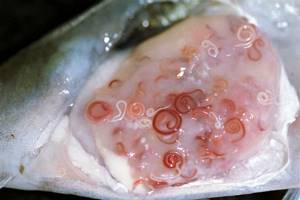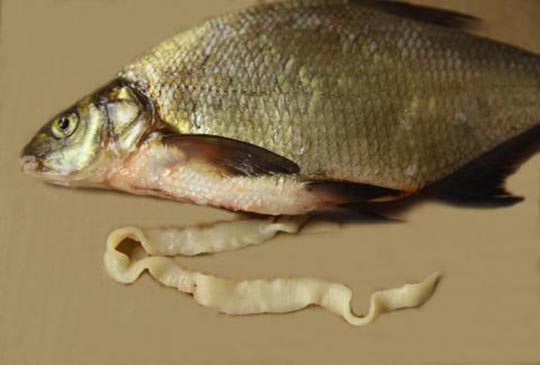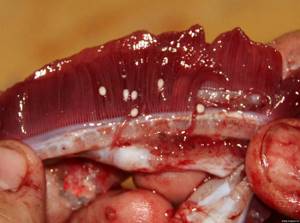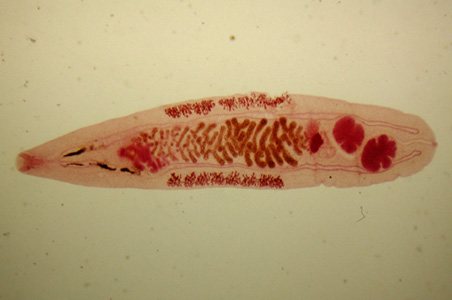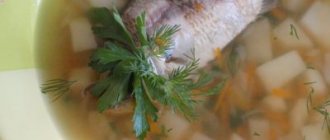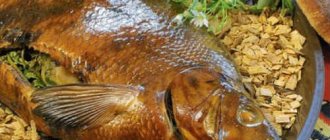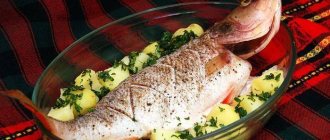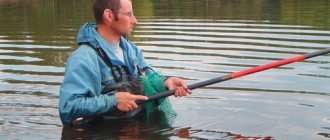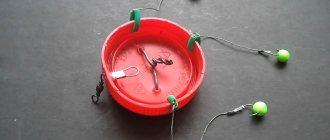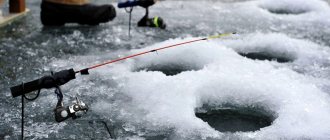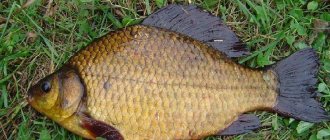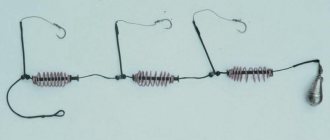Fish is an indispensable product in the human diet. However, its use often causes helminthiasis. Once in the human body, parasites can cause diseases that are not always treatable. Worms are found in fish regardless of the type of reservoir. According to statistics, river water is 95% infected, sea water is slightly less – 70%. Among the variety of different types of parasites, it is worth highlighting those that pose the greatest danger to people.
Worms in sea fish
There is a high probability of infection with helminthiasis when eating dishes prepared from sea fish affected by worms that have not undergone the necessary processing.
Tapeworms in pollock and sea bass
Pollock is one of the most accessible fish for the majority of the population. At the same time, it ranks first in terms of the degree of parasite infestation. The very popular sea bass is no less dangerous. A common type of helminth that affects these fish species is tapeworms. By carefully examining the insides of the fish when cutting, they can be detected even with the naked eye.
RECOMMENDATION! In frozen pollock and sea bass, parasite larvae are more difficult to detect. Therefore, it is recommended to clean the fish only after complete defrosting.
What do worms look like in pollock?
Helminths and their larvae in pollock are found on the inner surface of the abdominal cavity, viscera, and muscles. Among them are found:
- Cestodes are tapeworms that are most often found when cutting infected fish due to their size. The largest representative of this class is the broad tapeworm, an adult of which can reach a length of 10 m.
- Trematodes are flatworms that are almost impossible to detect visually.
- The Siberian fluke is a miniature parasite measuring no more than 12 mm. Outwardly, it resembles an elongated translucent leaf.
- Chinese fluke. Differs in larger sizes – up to 25 mm.
Even having an idea of what worms look like in fish, it is not always possible to detect them visually. The presence of many types of helminths is detected only through laboratory tests.
Diphyllobothriasis
One of the most common types of helminthiasis, the causative agent of which is the broad tapeworm, as well as other, less studied tapeworms. When a person consumes infected fish, he or she becomes the definitive host of the parasite. The disease does not have specific symptoms, so it is often detected when pieces of the worm are noticed in the stool. The organs of the digestive tract are mainly affected. The patient experiences periodic abdominal pain and weakness. Often there is upset stool, vomiting, lack of appetite, and changes in taste sensations. Sometimes allergic rashes occur in the form of hives.
Roundworms in herring, cod and pink salmon
Even fish, which is considered a delicacy, does not guarantee the absence of helminths. Poorly processed salmon, pink salmon, and chum salmon cause serious pathological processes in the body. Nematodes (roundworms) enter the human intestine in the stage of yellowish larvae. There can be up to a thousand worms in red fish. Fans of raw or lightly salted fish, sushi, and rolls are most at risk of becoming infected. Cod, beloved by many, is often affected by microscopic crustaceans, which, when decomposed, cause purulent processes.
What do worms look like in herring?
Parasites in fish are eliminated when exposed to high temperatures. However, herring is sold in a ready-to-eat form and is not subject to heat treatment. As a result, the risk of helminthiasis infection is quite high. Due to their presence in a saline solution, worms and larvae acquire resistance to an aggressive environment. Once in the human digestive system, they reproduce successfully. The most common worms in salted fish are:
- Cat fluke. A parasite with an elongated flat body about 3 cm in size, the causative agent of opisthorchiasis.
- Wide tape. A tapeworm that causes diphyllobothriasis.
- Anisakids. The worms are spindle-shaped, reaching a length of up to 6 cm. At one of its ends there are three lips.
The larvae of the latter are the most dangerous. They can cause anisakiasis, a serious disease accompanied by severe complications.
Anisakidosis
The larvae of the parasite are localized inside the gastrointestinal tract, which leads to damage to the mucous membrane with characteristic symptoms:
- Nausea, vomiting.
- Stool disorders.
- Flatulence.
- Pain in the iliac region.
- Allergic rashes.
In some cases, anisakidosis is accompanied by fever, cough, and sore throat caused by the reflux of bile into the esophagus. Lack of timely treatment threatens intestinal obstruction and peritonitis. Staying in the human body for 3 weeks to 3 months, helminth larvae cause irreparable damage to human health. Knowing about the consequences of anisacidosis, the question of whether it is harmful to eat herring with worms is no longer worth it.
Prevention of tapeworm in fish
In Finland, tapeworm larvae are found in the meat of pike, burbot, and perch. Tapeworm larvae can be found in both lake and sea fish. They are most often found in fish living in the waters of eastern and northern Finland.
In most marine areas of the country, fish are not infected. It is necessary to make sure whether the fish intended for cooking is contaminated or not. There is no need to exclude pike, burbot and perch from the menu in advance, they just need to be processed appropriately so that the tapeworm larvae die, and they die at DC temperatures.
If you boil or fry the fish in the usual way, the larvae will be killed. The cooking time should be at least 10-15 minutes. When frying, the size of the fish pieces is more important than their weight.
Small fish must be fried for at least 10 minutes. Fry fish weighing 700-1200 g or fillet 3-4 cm thick for 15-20 minutes. Pieces of fish larger than 6 cm, as well as large uncut fish that have not had their backbone removed, should be fried for at least 40 minutes.
Tapeworm in fish. Hot smoked fish, as well as carefully baked over an open fire, are harmless. Smoking devices come in a variety of designs, so it's hard to say how long it will take you to cook your fish. In small smoking boxes it is impossible to smoke fish well in a short time, for example in 8-10 minutes.
To prevent the fish from turning out too dry, you can proceed in this way: after the usual smoking time, remove the fire from under the smoking box, but leave the fish in the closed smoking oven for another 10 minutes. When the bones, especially the spine, and meat come off easily from smoked fish, the fish is ready and there is no danger of tapeworm infection.
A reliable way to avoid infection is to freeze the fish. Tapeworm larvae die at a temperature of -10°C. Fish weighing less than one kilogram is frozen in ordinary home freezers in 10 hours. (-18°C). In large fish, the larvae are destroyed if it is kept in the freezer for one day. The larvae also die with excessive salting. Salt must be taken in an amount of at least 12% of the weight of the fish.
Since stronger salting reduces the taste of caviar, it (like overly salted fish) is kept in the freezer for some time before eating.
You need to keep fish in salt for at least 5 days before eating (at temperatures above 10°C). If the temperature is higher, then add more salt or lengthen the salting time. To prepare pike caviar or burbot, salt should be taken in an amount of 10-12% of the weight of the caviar.
We repeat once again, precautionary measures apply mainly to certain types of fish, namely pike, burbot and perch. These precautions are explained to relieve people from unnecessary fear and encourage them to include fish dishes more often in their diet.
Worms in river fish
Inhabitants of freshwater bodies of water are affected by helminthiasis to a greater extent than marine fish. Roach, bream, carp, carp, crucian carp, and pike are often carriers of opisthorchiasis and diphyllobothriasis. When parasites enter fish through river mollusks, they cause diseases of the liver and digestive organs.
What do worms look like in crucian carp and bream?
River fish are susceptible to infection by various types of helminths. Among them are representatives of nematodes, cestodes, and trematodes. The most common are flatworms. The most common helminth is the broad tapeworm.
But along with it, other species can enter the human body:
- Ligula (ligula) is a flatworm, the length of which can reach 80 cm. Lake crucian carp is especially susceptible to infection with this parasite. Once in the intestines of the fish, the larva penetrates through its wall into the abdominal cavity. When becoming an adult, it grows to enormous sizes, sometimes causing rupture of the abdomen. This tapeworm is also dangerous for humans. The larvae can withstand salting and drying, dying only when exposed to high temperatures.
- Cat fluke. It often affects crucian carp, carp, and bream. They cause a rather dangerous disease - opisthorchiasis. Small fluke larvae cannot be detected with the naked eye.
Settling in the human small intestine, these parasites provoke the development of serious diseases.
Opisthorchiasis
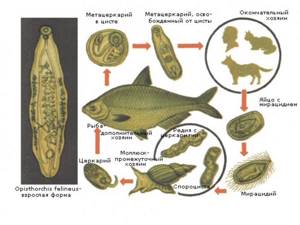
Representatives of the carp family are most often carriers of this disease. Penetrating into the human body when eating unprocessed fish, helminth larvae cause headaches, fever, and pain in the abdominal area. Prolonged course of the disease leads to liver cirrhosis and death.
Clonorchiasis
A disease caused by the Chinese fluke. It can occur in acute or chronic form. Characteristic symptoms are liver enlargement, yellowing of the skin, rash, nausea, diarrhea, muscle pain, fever. The biliary system and pancreas are affected. If left untreated, clonorchiasis can lead to complications such as liver abscess, cholelithiasis, and acute pancreatitis.
Metagonimiasis
It is caused by the smallest representative of flatworms, measuring no more than 2.5 mm. Symptoms of the disease are mild. For a long time (sometimes up to a year) a person may not be aware of the infection. An uncomplicated course is characterized by intestinal disorders that do not pose a serious health hazard. In severe cases, metagonimiasis can lead to brain damage. Like meat, raw fish can cause the development of enterobiasis, a disease caused by pinworms.
Worms in fish: are there river or sea fish? Is it possible to eat raw or salted fish with worms?
- Are there worms in sea and freshwater fish?
- What are these worms and what do they look like?
- Is it possible to eat such fish?
- What could be the consequences?
- What to do with fish with worms
- Which fish are free of parasites and worms?
- Worms in aquarium fish
Infection with worms is a danger that many people neglect or pretend does not exist. Worms not only disrupt the functioning of human organs, but also poison the body with the products of their vital activity.
Are there worms in sea and freshwater fish?
Before discussing whether there are worms in fish, I would like to cite some extracts from a regulatory document approved by the Ministry of Fisheries back in 1988 and which has not lost its relevance in our time.
The document is called “Methodology for parasitological inspection of sea fish and fish products (raw sea fish, chilled and frozen fish)”
Quote: “We must remember that there are no and cannot be fish that do not contain parasites. Therefore, the very fact of detection of parasites cannot be grounds for rejecting fish or reducing its grade; it is necessary to take into account what parasites are encountered, in what condition and in what quantity.”
This is an extract from an official document. The title of the document is given in full, and those who wish to read it in detail can find it on the Internet.
What are these worms and what do they look like?
Oriental fluke lanceolate fluke liver fluke Siberian fluke pinworms roundworms head lice lamblia Siberian fluke cat fluke blood flukes bovine and pork tapeworms
The table lists the worms found in fish that pose a great danger to humans.
| Name of worms | Appearance | Diseases they cause |
| Anisakids | Roundworms are 55 - 65 mm long with a body pointed on both sides. The larvae that are in the capsule and move freely are dangerous for humans.
| Anisakidosis |
| Diphyllobothrium (Broad tapeworm) | A tapeworm with a length of 10 to 20 m. The body consists of 3 parts: head, neck and segments containing genitals. There can be more than 3000 of these segments.
| Diphyllobothriasis |
| Clonorchis (Chinese fluke) | A flatworm, 10 to 20 mm long, belongs to the group of trematodes (liver flukes). It has a dark red translucent oval shaped body.
| Clonorchiasis |
| Opisthorchi (Siberian fluke) (Cat fluke) | Flatworm 18 mm long, up to 2 mm wide. In the upper part there are two suction cups, with the help of which it is attached to the organs; the uterus with eggs is located in the middle part.
| Opisthorchiasis |
Is it possible to eat such fish?
If you are concerned about the quality of the fish, it is better not to buy it. Lightly salted, dried, smoked fish contains a large number of worms. Any deviation from the technology of preparing fish is fraught with dangerous consequences. Eating such fish is strictly prohibited! Rolls and sushi have become very popular lately.
Few people think that red fish, which gives sushi and rolls such an unusual, piquant taste, is not heat-treated. The probability of becoming infected with worms found in such fish is close to 100%. Is it worth the risk?
What could be the consequences?
The consequences after eating fish infected with worms can be not just sad, but also tragic. It is naive to think that worms live only in the intestines and do not cause much harm. These parasites penetrate all human organs, leading to a variety of consequences.
Larvae and adults are found in the lungs, brain, liver, and heart. The movement of larvae through the bloodstream is especially dangerous. Worm infestations can be fatal. Unfortunately, these cases are not isolated. The biggest danger is that helminths can live in the human body for years.
Poison the body for years without revealing yourself. Poor health, fatigue, decreased immunity is just the surface of the iceberg. Worms such as the broad tapeworm grow up to tens of meters. Twisting in the intestine, they block its lumen, and intestinal obstruction occurs. In this case, only surgical intervention can save life.
Another type of worm, such as the Chinese fluke, has suckers and uses them to cling to the intestinal walls. This often leads to deformation of nerve endings, and as a result, necrosis. It is not easy to destroy them in the body.
When they die, they release toxins, which also lead to serious complications. Therefore, in addition to deworming, it is necessary to take medications that will help remove dead worms from the body.
Don't self-medicate! Only a doctor, based on tests, will prescribe a treatment regimen with anthelmintic drugs!
What to do with fish with worms
If worms are found in lightly salted, dried or smoked fish, the answer is clear: it is strictly forbidden to eat such fish. In other cases, you can subject the fish to thorough heat treatment.
Heat treatment recommendations:
- Spread the fish along the ridge.
- Cook for at least 20 minutes.
- Fry for 20-25 minutes.
- Bake fish pies for at least 30 minutes.
With this treatment of fish, the worms die completely, and you will not receive any harm from such a necessary and valuable product.
There is another, no less effective, way to destroy worms in fish. This is deep freezing. The fish should be kept in the refrigerator for 5 days, at a temperature no higher than -20°C.
In modern refrigerators, it is possible to set the temperature of the refrigerating chamber to -24°C (it can be set independently using an electromechanical regulator), but in the warm season, deviations from the set temperature are possible.
If you are not sure that this temperature is maintained constantly, store the fish in a refrigeration device for up to 2 weeks.
Which fish are free of parasites and worms?
Unfortunately, all fish in any natural reservoirs are infected with parasites. The exception is fish bred in artificial reservoirs, where measures are regularly taken to prevent fish diseases.
You will be surprised how many parasites will come out if you drink a glass of regular...
Parasites will leave the body in 3 days! You just need to drink on an empty stomach...
Be sure to heat treat any raw fish, no matter where you purchase it!
Worms in aquarium fish
Aquarium fish also suffer from worms.
Methods of infection:
- Through live food.
- From untreated water.
- From new, acquired fish.
Prevention:
- Live food must be kept in water for several days for the parasites to come out naturally.
- Clean the water thoroughly before adding it to the fish.
- Keep new fish in quarantine for 2-3 weeks.
Aquarium fish worms are not dangerous to humans. The temperature of our body is detrimental to parasites of aquarium fish. And they are not eaten. To prevent infection, it is enough to wash your hands with soap after various manipulations with the aquarium.
Don't be careless! Follow all the recommendations listed in the article.
- Dispensed without a doctor's prescription;
- Can be used at home;
- Clears parasites in 1 course;
- Thanks to tannins, it heals and protects the liver, heart, lungs, stomach, and skin from parasites;
- Eliminates rotting in the intestines, neutralizes parasite eggs thanks to the F molecule.
A certified remedy recommended by helminthologists for getting rid of parasites at home. It has a pleasant taste that children will like. Consists exclusively of medicinal plants collected in environmentally friendly places.
?Expert opinion about the drug.
Is it possible to eat fish with worms?
Having discovered worms during cutting, you should not always rush to get rid of the valuable product. You can eat fish with worms after thorough heat treatment. Under the influence of temperatures below 25⁰С and more than 100⁰С, the parasites completely die, and the product becomes suitable for consumption.
What to do if you eat fish with worms?
If you have eaten raw or insufficiently processed fish infected with parasites, you should consult a doctor. If helminthic infestation is confirmed after tests and examination, appropriate therapeutic measures are taken.
Precautions: Proper Handling
Considering that almost all river fish are infected with helminthiasis, a person can only protect themselves from this disease by strictly following the rules for its preparation:
- You need to cook the fish for at least 20 minutes from the moment the water boils. A large carcass should be cut into pieces. Each side is fried for 10 minutes.
- Salting should be done in 2 kg portions. The safest fish is kept in the cold for 20 days in a strong salt solution.
- Worms in frozen fish are completely destroyed. In order to prevent helminths, freezing it in the freezer should be carried out for at least two weeks.
Is it possible to eat fish with tapeworm?
How dangerous this helminth is for humans is a controversial issue. Many enthusiasts believe that properly cooked fish meat will avoid infection. You can eat a product that is well thermally processed. Unspoken rules:
- fried fish is eaten after processing at a temperature of 55-60°C;
- frozen products - at a temperature of -18-20°C.
Please note that with this processing, a small amount of useful substances is retained in fish meat. But doctors recommend treating the problem more rationally. It’s better not to joke with your health and exclude fish infected with parasites from your diet. As a preventive measure, it is recommended to take anthelmintic drugs, and additionally you can undergo medical tests.
In terms of external signs, the meat of fish infected with a tapeworm does not differ from uninfected products. The key difference is a decrease in taste and nutritional value.
- Tapeworm in the brain
Origin of the species and description
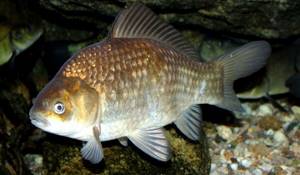
Crucian carp belongs to the carp family and belongs to the class of ray-finned fish from the order Cypriniformes. Its name comes from old German dialects and the exact meaning of the word is unknown. This genus of fish is very widespread in various freshwater bodies of water. There are several varieties of crucian carp, which we will now describe.
Common (golden) crucian carp has a flat but rounded body shape. The fin located on the back is quite high and has a dark brown tint, like the tail. The remaining fins are smaller and have a reddish color. The sides of the crucian carp are covered with large golden-copper scales, and its back is dark – brownish. The belly of the fish is light in color compared to the ridge and sides. There are very large specimens of this crucian carp, the weight of which reaches 5 kg, and the body length is up to half a meter.
This crucian carp spread throughout Europe, settling in:
This type of crucian carp also lives in China, Mongolia, and the Asian part of our country, choosing overgrown, swampy, muddy reservoirs.
Silver crucian carp was first an inhabitant of rivers belonging to the Pacific basin, but since the middle of the last century it was artificially resettled on the North American continent, in India, Siberia, China, the Far East, Ukraine, Poland, Latvia, Belarus, Romania, Italy, Germany, Portugal. It is worth noting that in many places of new settlement this crucian carp gradually replaced its golden relative, in comparison with which it is significantly inferior in size.
The mass of silver crucian carp practically does not exceed three kilograms, and its longest length can reach up to 40 cm. The fish has large scales, painted in a silver-grayish or grayish-green tint. It is very rare to find fish that are golden or orange-pink in color. All fins of this type of crucian carp are colored in a grayish-olive shade and are transparent.
The silverfish has a unique ability that allows it to adapt to its environment and change its appearance in accordance with it, thanks to this people have developed a new variety called the “goldfish”.
Goldfish has many subspecies, numbering several hundred. Almost all of them are aquarium fish, the length of which varies from two to forty-five centimeters, and the bright colors are very diverse.
The shape of a goldfish can be:
- spherical;
- elongated (elongated);
- ovoid.
In addition to differences in shapes and colors, this type of crucian carp also differs in the size of its fins. The eyes of these fish can be either small or large, strongly convex.
It is on goldfish that experiments necessary for scientific research are often carried out; they are the first fish to have been in outer space.
Japanese crucian carp lives in Japanese and Taiwanese waters, the wild variety can be seen in the Japanese Lake Biwa, the dimensions of the crucian carp are from 35 to 40 cm.
What kind of worms are there in fish: photo and description
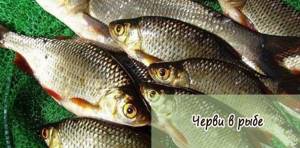
Recently, the cuisines of many peoples of the world offer exotic fish dishes that do not undergo proper heat treatment. Raw, smoked or salted fish is found on the holiday tables of every second inhabitant of the planet, while few people think about how many dangers such food implies. Fish and meat carcasses are the most common sources of helminthiasis in humans, although many fish worms do not pose a danger to the human body. For example, red worms in fish are phylometra, which are safe for humans and only spoil the presentation of the fish.
Regardless of whether the fish is freshwater or saltwater, there may be dangerous parasites inside it, the final host of which becomes a person. The disease can be detected immediately after the incubation period, but there are also hidden forms of helminthiasis that are asymptomatic. This significantly affects human health, since any parasite causes damage to the internal organs and systems in which it is localized.
What do worms look like in fish?
Today, all parasites existing in nature can be divided into three types - nematodes, trematodes and cestodes. The same applies to fish, in whose body parasites are divided according to the same principle. Many of them can be identified with the naked eye, but not all.
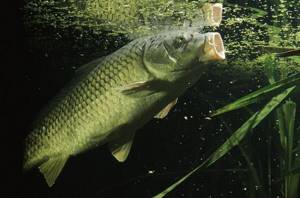
- Roundworms are nematodes: worms in fish meat can be either freshwater or marine. Among this type of parasites, there are many subspecies that inhabit the body of fish. Many can be seen when cutting a carcass, for example, the larvae of the Anisakidae family look like thin spiral-shaped worms 1.5-2 cm long.
- Trematodes are flatworms in fish: only some subspecies pose a zoonotic threat to humans, and it is almost impossible to visually detect worms in a carcass.
- Cestodes are a tapeworm in fish: due to the large size of such pests, they are most often visually detected in a fish carcass when working with the product. We are talking about small white larvae 1-2 cm in length, as well as small cysts with larvae.
Thus, it becomes clear that almost all types of worms can be noticed during the process of cutting fish, provided that the product is carefully examined.
Worms in fish: photo and description
The body of a fish can harbor millions of worms that parasitize through its resources. And only some of these helminths pose a danger to humans.
- Opisthorchiasis - we are talking about the Siberian fluke, such flatworms in fish suggest a size of 7-12 mm. Such parasites, entering the human body, settle in the liver and bile ducts, gall bladder or pancreas. The incubation period lasts about two weeks, after which the person feels the first symptoms.
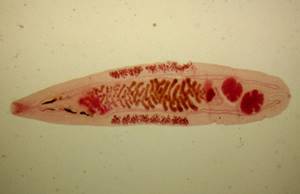
- Clonorchiasis is a Chinese fluke; such worms in fish meat are typical of a tributary of the Amur, as well as reservoirs in Vietnam, Korea and China. After the incubation period, clonorchiasis is manifested by an increase in liver size, temperature, and skin rash.

- Diphyllobothriasis is a broad tapeworm that is often found in fish and people wonder if there is a tapeworm in the fish, can such a product be eaten? In fact, this is one of the most dangerous parasites for humans, causing nausea and vomiting, belching, excessive salivation, weakness, rumbling in the stomach and heartburn, bowel dysfunction and headaches.

- Nanophyetosis is small roundworms in fish meat, about 5 mm in length, which cause heavy and persistent loose stools in humans. After this, the disease leads to anemia.
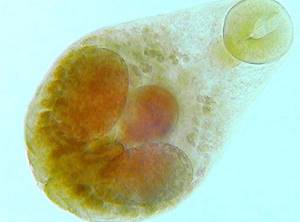
- Metagonimiasis - worms enter the human intestines; the disease is found in the Amur region, China, Korea, Vietnam, the Philippine Islands and Japan. A week after infection, a person notices a rash, diarrhea, fever, pain in the abdomen and on palpation.
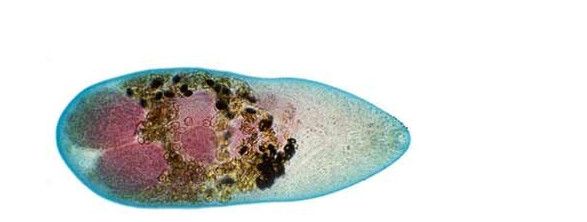
- Anisakiosis - roundworms are found in Japanese dishes, where raw fish predominates. The larvae of this parasite provoke the development of ulcers in the intestines; the symptoms of such helminthiasis are similar to other types of helminthic infestations.
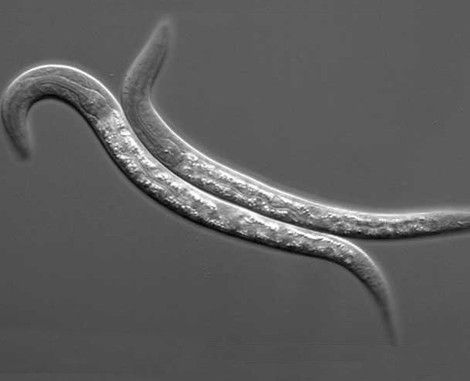
- Ligulosis are long flatworms about 120 cm long, that is, the saltpeter worm in fish from freshwater sources. If such a parasite is removed from the fish carcass, the product is suitable for consumption.

What to do if you eat fish with worms?
The main rule for eliminating the danger in the presence of worms in fish is sufficient heat treatment of the food product during the cooking process. Even if there were any helminths, if prepared correctly, they were all neutralized. At temperatures of -25 degrees and below, fish are considered disinfected after 15 hours of frost treatment. In the case of salting, the helminths die within 10-14 days; dried fish are kept for at least 3 weeks.
If the fish was raw or undercooked, and worms were found inside, you need to consult a doctor and get tested. In addition, prophylactic use of anthelmintics would be appropriate. The carp family is considered the most dangerous fish species.
Culinary commandments against fish helminth infections
In fact, the presence of parasites in a fish’s body does not mean that the product is unfit for consumption. It is enough to thoroughly heat-treat the fish to neutralize any worm inside it. If you need to prepare raw fish for salting or smoking, it is important to select artificially grown fish that have been raised and fed artificial feed.
Sea fish should be eaten immediately after catching; if this is not possible, it should be frozen immediately after catching. Sterlet and sturgeon are considered the safest fish, which are rarely affected by worms; such products can be consumed raw. Other types require marinating, smoking, and salting according to the rules. To destroy parasites in fish, you need to boil it for 15-20 minutes, fry it for the same amount of time, and bake it for at least 30 minutes.
Appearance and features

Photo: Crucian fish
Having understood the individual characteristics of each variety of crucian carp, it is worth giving a general description of the appearance of this very common fish. Externally, crucian carp is very similar to carp, this is not surprising, because they are members of the same family. When comparing them, the most important distinguishing feature is the smaller head. The mouth of the crucian carp is also smaller than that of the carp and does not protrude forward as much; it does not have a mustache.
The body shape of the crucian carp is oblong, but high, somewhat reminiscent of a diamond; the body of the fish is flattened on the sides. The large dorsal fin has a smooth outline. The fish is covered with smooth and large scales, the colors of which vary between species, but the most common colors are golden and silver. The fish ridge is quite powerful and thickened.
The small mouth opening contains single row pharyngeal teeth. Basically, the eyes of crucian carp are small. One of its differences is the presence of prickly barbs on the anal and dorsal fins. The standard weight of crucian carp is from 200 to 500 grams; larger and heavier specimens are rarely found.
The life span of different types of crucian carp is different. The Golden Krasya can be considered a long-livers; it can live more than 12 years. Goldfish rarely survive nine years of age, although some manage to overcome this milestone and live for a couple more years, but this happens extremely rarely.
Where does crucian carp live?
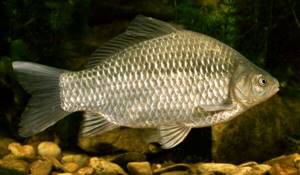
Photo: Big crucian fish
It should not be surprising that crucian carp is so widely distributed throughout the globe, because it is very hardy and unpretentious. The widest range of crucian carp was also facilitated by human activity, who settled it in many places artificially. This fish adapts perfectly to all kinds of ponds, lakes, and rivers.
Ichthyologists have found that in swampy areas, underwater holes and when a large amount of silt accumulates, crucian carp feels most at ease and begins to reproduce much more actively. Only water bodies located in mountain ranges avoid crucian carp.
Under unfavorable conditions (excessive frosts, severe drought), crucian carp burrows deeply into the silt (up to seventy centimeters) and successfully survives all natural disasters there.
The crucian carp did not ignore Italy, Poland, Portugal, Germany, Romania, Great Britain, Hungary, Kazakhstan, China, Belarus, Mongolia, Korea, where they live safely. This fish does not disdain the cold Siberian waters, having chosen Kolyma and Primorye. Crucian carp can also be caught in the territories of Pakistan, India, the USA and Thailand.
As you can see, the geography of crucian carp distribution is very wide; it has a permanent residence in other countries not listed here. Here you can catch it almost everywhere; it feels great, both in wild and artificially created conditions. Fishing enthusiasts will undoubtedly confirm this.
The Chinese were the first to begin artificial breeding of crucian carp; this happened back in the seventh century AD.
What does crucian carp eat?

Photo: River fish crucian carp
Crucian carp can be called an omnivorous aquatic inhabitant. Its menu is quite varied. Let's trace the taste preferences of fish, starting from the moment of birth. The fry that are born have a yolk sac with them, which remains with them after embryonic development; they use the contents of this sac for nutrition, which maintains their strength and energy.
Slightly mature crucian carp begin to feed on daphnia and blue-green algae. Closer to the month, bloodworms and larvae of various insects living in the water appear in the babies’ diet.
Mature fish have a richer and more varied menu. Their diet includes annelids and small crustaceans, all kinds of insect larvae. The roots and stems of plants in the coastal zone also serve as food for crucian carp. He loves to eat duckweed and various algae.
Fishermen have long understood that crucian carp are not averse to eating all sorts of cereals:
The buttery dough and crumb of bread for fish are real delicacies. Crucian carp's sense of smell is simply excellent, so it senses a particular type of bait from afar. It has been noticed that crucian carp like harsh and strong odors (for example, garlic), which fishermen use for their baits.
The lateral line of crucian carp can be called an organ of its finest sensitivity, with the help of which the fish scans the water column, receiving data about the location of prey, its dimensions, and the distance to it. It also determines the presence of predatory ill-wishers.
From the fact that crucian carp did not like hornwort, it contains a lot of tannin, which repels insects and larvae, which crucian carp like to eat.
Social structure and reproduction
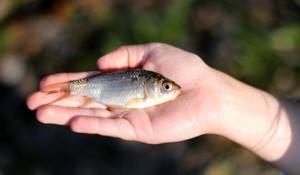
Photo: Small crucian carp
As for the social structure of crucian carp, these fish can be called schooling, although it happens that specimens that are quite large in size prefer to live completely alone. Crucian carp are sedentary and very cautious fish, but during the spawning period they can go to the nearest river tributaries.
Crucian carp become sexually mature when they are closer to four or even five years old. Usually, their spawning period occurs in May-June, it all depends on how warm the water is; its temperature should be about 18 degrees plus. Spawning can take place several times a year. At this time, the crucian carp is not interested in food at all, so catching this fish is useless.
To spawn, females move closer to the shore, where there is more vegetation. The spawning of crucian carp is multi-stage, taking place with ten-day breaks. One female can lay up to three hundred thousand eggs. They all have excellent stickiness and cling to aquatic plants.
Crucian carp caviar is light yellow in color, and the diameter of the eggs is only one millimeter. After about a week, embryos emerge from it, about four millimeters long. Closer to the autumn period, babies can grow up to 5 cm in length. Typically, their survival rate is 10, and this is under favorable circumstances. Scientists have noticed that goldfish give birth to much more females than males (approximately five times).
The size of crucian carp and their development depend on the amount of food. If it is in abundance, then already at the age of two years the fish has a mass of about 300 grams; with meager food, crucian carp can survive, but will weigh only a few tens of grams at the same age.
A process such as gynogenesis is characteristic of crucian carp. It occurs when male crucian carp are not observed in the reservoir. The female has to spawn with other fish (carp, bream, roach). As a result of this, exclusively female crucian carp are born from eggs.
Parasites living in fish. Danger to humans
Fishing professionals know that all types of fish contain parasites, because they encounter such “guests” quite often. After opening the fish, during its preparation, people, finding large worms, throw it away, despite the fact that many varieties of large parasites are absolutely harmless to humans.
- Parasites living in raw fish
- Harmless parasites for the human body
- Helminths
- Schistocephamos
- Cystidicola farionis
- Trienophorus nodulosus
- Philometra
- special instructions
- Diphyllobothrium latum
- Diffylbothrium dendriticum
The real danger is posed by small species of parasitic worms. As a rule, fishermen who know a lot about this matter do not throw away useful fish meat, but, armed with certain knowledge, skillfully deal with parasites without damaging their own refrigerator.
Parasites living in raw fish
All varieties of commercial fish, without exception, must undergo special veterinary and sanitary control before being sent for sale. These rules are accepted and used everywhere, regardless of region. A serious problem in this area is caused by unscrupulous amateur fishermen who fish and sell their catch, which subsequently leads to the fact that the people who made the purchase become infected with parasites. There are certain signs by which infected individuals can be distinguished, but not every person is familiar with them. That is why diseases caused by parasites living in fish are now quite common.
Harmless parasites for the human body
There are a number of parasitic worms that, while causing harm to fish, remain practically harmless to humans. It is important to promptly identify infected individuals and take special measures during cooking. This will help prevent the consumption of larvae and adults found in many types of fish. Experts recommend completely eliminating this food product from the diet if you do not have certain cooking skills.
Helminths
Parasites of this type are most often found in fish. Mostly the carp family is infected: silver bream, bream, rudd. The most dangerous and fairly large parasitic worm is the ligula, which can be seen in the photo. This worm reaches more than 15 cm in length at maturity. Due to its large size, the parasite causes metabolic disorders in the human body, which is fraught with serious consequences.
If you find a ligula inside a fish, you should not rush to throw it away. It is recommended to clean the fish from the entrails, along with which the parasitic worm is removed. After washing the meat, you can safely eat it, since there is no danger to humans in this case. The larvae of the worm do not penetrate the muscle structures of the fish, which eliminates the possibility of infection.
It is important to prepare the product correctly, giving it the heat treatment necessary to kill parasites. Otherwise, in the presence of smaller types of helminths, there is a possibility of human infection with helminthiasis. The disease is the penetration of parasites such as trematodes, cestodes and roundworms into the human body. In the human body, the parasite can be localized in the internal organs or in the subcutaneous tissue.
Schistocephamos
A fish such as crucian carp can contain worms that are slightly smaller in size than ligula - digramma. You can see what the parasite looks like in the photo. Smelt often contains parasites such as schistocephamos, which reach no more than 2 cm in length, as shown in the photo. These parasites are practically harmless to humans, as they are not capable of harming their internal organs. This type of parasite can be found in the intestines of red fish such as trout and salmon.
If such parasites are found, it is recommended to gut the fish entrails and bury them in such a way that animals cannot reach them. Fish can be eaten after thorough washing and cooking.
Cystidicola farionis
In winter and spring, when the greatest activity of smelt is observed, many fishermen wonder whether contaminated fish can be eaten. The parasite is located in the swim bladder and has a peculiar appearance: a thin, thread-like parasite. Cystidicola pharyonis is a thin round worm. It does not harm the human body, but despite this, it is recommended to remove all entrails before cooking smelt.
Trienophorus nodulosus
White balls can often be found in the liver of burbot. When they are damaged, as a rule, a flatworm emerges, which can be seen in the photo. Its length varies between 10-12 cm. Cysts can also be found in other fish. Infected fish can be eaten, the main thing is to completely clean its insides of parasites and cook it, observing certain standards.
Philometra
Fish caught in fresh water bodies may contain thin parasitic worms, which can reach up to 10 cm in length. This parasite is localized in the gill area or under the scales. In the carp family, this worm is most common, localized under the scales in the area where the upper fin is located. In appearance, this parasite resembles veins. Infecting humans is impossible. The intermediate host is crustaceans, without which the parasite cannot be transmitted.
special instructions
Please note that if large helminths are found in the internal organs of the fish, you should not dispose of the entrails by throwing them back into the reservoir. This method of getting rid of parasites risks infecting other fish.
Important! If, when cutting freshly caught fish, you find signs or the parasite itself, do not throw it away, but burn it in order to most likely avoid further development of the “freeloader”.
You should not refuse to eat fish dishes, but it is important to follow a number of recommendations with which you can protect your body from infection:
- do not taste raw fish when cooking;
- boil or fry fish for at least half an hour;
- Before cooking, be sure to cut the meat into small cubes, no more than 1 cm;
- Freeze fish meat first.
Dangerous parasites for the human body
Small parasitic individuals, the length of which is up to 5 mm, are really dangerous to humans. It is important to promptly determine the presence of worms in fish, which eliminates the possibility of infection. Otherwise, there is a danger of contracting quite serious diseases that are difficult to treat.
Diphyllobothrium latum
The parasite that lives primarily in the eggs and gills of fish is called Diphyllobothrium latum. A person can become infected by consuming an improperly prepared product. The meat of perch, burbot or pike is predominantly contaminated. Inside the human body, diphyllobothrium larvae can reach 30-50 meters in length. There have been cases of infection of people in whose bodies the parasitic worm lived for 10 years or more.
Diffylbothrium dendriticum
Parasitic individuals live exclusively in reservoirs on the territory of the Russian Federation. The larvae are found in fish, and after entering the human body they can grow up to 1 meter in length. The worm lives for six months, but in a fairly short period of time it provokes a large number of pathologies in humans.
What to do if dangerous parasites are detected?
Experts recommend excluding fish infected with any type of diphyllobothrium from the diet. You can see what the parasite looks like in the photo. In case of exception, it is permissible to eat contaminated fish, provided that cooking recommendations are followed, but only if you have certain skills:
- thoroughly clean the fish;
- cut into 1 cm pieces;
- boil for 30-40 minutes.
To salt infected fish, it is necessary to keep it for 10-12 days at low temperatures, and then leave it for 7-8 days at room temperature in a saline solution. Salt must be added in an amount of at least 3 parts by weight of the fish. Careful preparation and handling of infected fish does not guarantee that infestation will not occur. That is why, to avoid the development of serious diseases, you should not include contaminated fish meat in your diet.
Parasites living in herring
Russian cuisine does not have dishes with raw fish. But in this case we should not forget about the herring. This type of product is quite popular due to its taste and low cost. Not every manufacturer follows the technology for making herring, so contamination cannot be completely ruled out when consuming this product.
Herring may contain various parasites that are causative agents of the following diseases:
- Ligulosis is caused by a tapeworm that reaches 120 cm in length while living in the human body. The parasite compresses almost all internal organs, which provokes their dysfunction, and also releases waste products that cause intoxication of the body. In this case, symptoms such as fever, dizziness, nausea and diarrhea are observed.
- Opisthorchiasis occurs when a cat fluke enters the human body. The disease is accompanied by damage to the gallbladder and ducts, pancreatic gland and liver tissue. The parasite multiplies quickly, causing symptoms such as a bitter taste in the mouth, headaches, fever, constipation and diarrhea.
- Anisokidosis is a common helminthiasis that is detected in fish and also affects human internal organs. In this case, parasitic individuals live in the intestinal space. Primary symptoms include pain in the abdomen and periodic vomiting. Quite often the disease is mistaken for the acute stage of appendicitis. Anisokidosis is accompanied by the development of characteristic intestinal bleeding, because the parasite cuts into the walls, which is the cause of the development of pathology.
- Diphyllobothriasis – by eating herring you can become infected with the broad tapeworm, which can grow up to 25 meters in length in the human body. Clinically, the disease is manifested by complete or partial loss of appetite, headaches and quite severe dizziness, pain in the peritoneum, enlargement of the spleen and liver.
The most dangerous diseases
Among the most dangerous diseases that occur when eating herring is dioctophimosis. In this case, helminths affect the bladder, ureters and kidneys of humans or carnivores, mainly dogs. The eggs of parasitic worms settle in the area of the renal pelvis, where they develop until they reach sexual maturity. In this case, dysfunction of the genitourinary system occurs, which is accompanied by complications such as renal failure. Dioctophimosis can only be treated surgically.
Among the dangerous helminthic infestations, one can highlight ink-spot disease, which infects fish that contain the causative agent of post-diplostomosis in their bodies. This disease is not very dangerous, but experts recommend refraining from eating fish that have dark spots on the body.
How to distinguish infected fish
A product that is unfit for consumption has certain differences, knowing which you can protect yourself from infection:
- Infected fish have damaged muscle structures. When pressed, the resulting hole does not level out.
- The pupils of the fish are cloudy, and the mucous membrane is usually dry.
- The belly of the fish is saggy and swollen.
- The gills acquire a characteristic swampy hue, and the internal organs of the fish have a foul odor during cutting.
- The anus protrudes above the main body of the fish and viscous, cloudy mucus flows out of it.
When preparing contaminated fish, the broth has quite specific characteristics. The broth is usually cloudy. There is no fatty film on its surface. Instead, the broth contains a mass of dark particles and flakes of unknown origin.
Natural enemies of crucian carp
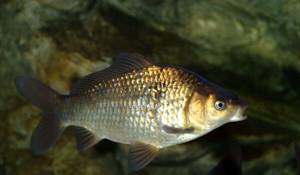
Photo: Crucian fish
It is not surprising that larger predatory fish are enemies of crucian carp. The first among them is the pike, which simply loves to snack on crucian carp. Just remember the well-known saying: “That’s what the pike is for, so that the crucian carp doesn’t sleep.” Clumsy crucian carp can also be caught for lunch by fish such as pike perch and asp.
Of course, adult and large crucian carp have many times fewer enemies than young animals, fry and eggs of this fish, which often end up in the mouths of newts and frogs. They destroy eggs and newborn fish in huge quantities. Surprisingly, various aquatic insects (garglers, bugs, swimmers) attack crucian fry with great aggressiveness, and the gluttony of their larvae is simply amazing.
In addition to troubles from the water column, the crucian carp is also subject to lightning-fast air attacks from birds. Kingfishers and seagulls like to eat crucian carp this way. Birds can also carry dangerous fish diseases. Waterfowl ducks are also not averse to feasting on small crucian carp, and long-legged gray herons eat dozens of them.
Animal predators are also not averse to grabbing crucian carp, which can become a tasty snack for otters, muskrats, muskrats, and ferrets. Even the common red fox manages to catch crucian carp in shallow water if she is lucky.
As you can see, crucian carp have a lot of bad friends, especially young ones. But most of all crucian carp are destroyed by people who are keen on fishing. Usually crucian carp bites well on a regular float rod, although there are many other devices for catching it (spinning and feeder fishing, elastic, donka). Fishermen have long studied crucian carp habits and taste preferences, so they know how to attract this fish. As a fishery, crucian carp are highly valued. Their white and tasty meat is considered dietary and very healthy.
